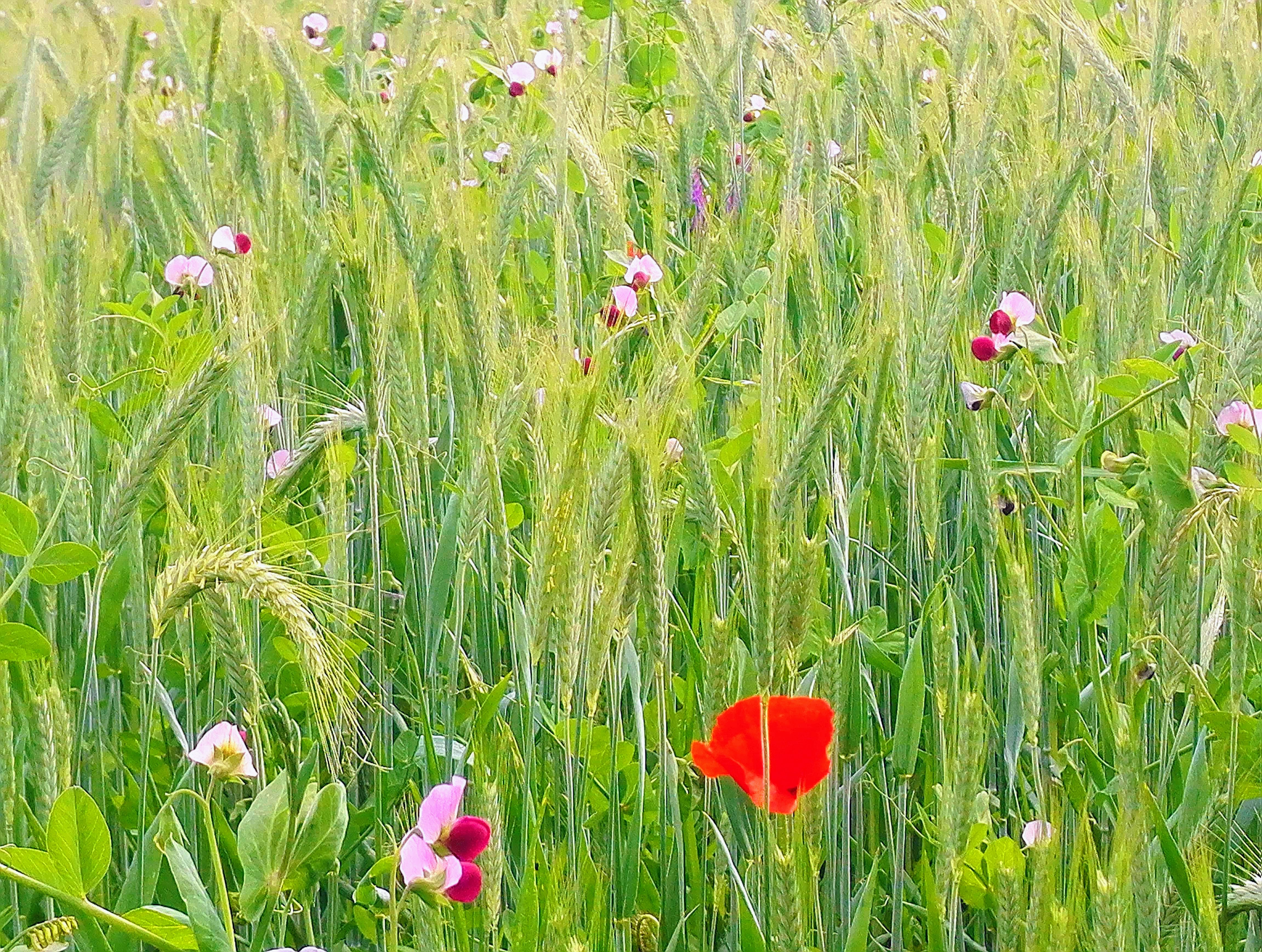Arable crop combinations
 Which crops to choose, what benefits to aim for, which combinations to avoid...
Which crops to choose, what benefits to aim for, which combinations to avoid...

Crop association is defined as the simultaneous cultivation of two or more plant species on the same agricultural plot[1]. The species or varieties combined in this way do not have to be sown and harvested at the same time, and can be grown as a mixture or in alternating rows.[2]. This practice offers a range of agronomic potential, the technical aspects of which are covered in this portal.
Mixed species
Double-harvest associations
In this type of association, all the crop species are harvested. The most common examples are meslin or other combinations of cereals and/or legumes. These mixtures of annual species are more easily exploited on mixed livestock farms through the production of hay or silage, than on arable farms where the grain has to be sorted after harvesting.
- Feedback from Michel Bromet (11), on theintroduction of forage meslin in mixed farming (as part of the Aglae project).
Temporary associations
This is an association between a main crop, intended to be harvested, and a secondary crop that will provide cover before the main crop or the following one is sown. Rapeseed is the most frequently cited example. As with intercropping, the secondary crop generally meets a specific agronomic criterion :
- It can act as agreen manure, for example when a leguminous cover crop is sown to replace a cereal crop, or as an Intermediate Nitrate Trapping Crop(INTC).
- It can be used to combat pests and diseases : for example, by acting as a pest trap (example : combining oilseed rape with an early cruciferous crop to trap meligetes) via a push-pull effect, or as an allelopathic/biofumigant cover for diseases and pests, or to smother weeds.
Permanent cover
This type of association is set up for several years and involves widespread use of direct seeding under plant cover. This is a technique borrowed fromsoil conservation agriculture, the aim of which is to maintain plant cover over a large part or even the entire rotation, in order to sow the main crops. This is known as direct seeding under living plant cover. This practice is generally incompatible withOrganic Farming, as it requires the use of herbicides to regulate the cover. Whether the cover is temporary or permanent, it is vital to choose the composition of the plant cover meticulously.
- Conference by members of the MAGELLAN GIEE, on the establishment of permanent cover.
- Feedback from Ferme du CHAUMOY (18), on the use of direct seeding under cover (DePhy EXPE).
All the practices relating to permanent cover can be consulted on the"Permanent cover in arable farming" portal.
Agroforestry
Agroforestry is defined as theassociation of trees and crops or animals on the same agricultural plot, and can therefore be considered as a mixture of species. Although difficult to implement, this practice offers a number of benefits :
- combating soil erosion.
- The creation of a microclimate that favours crop yields ( windbreak and limitation of evapotranspiration).
- The development of auxiliaryinsects to limit pest attacks.
- Soil conservation.
The LER or "Land equivalent ratio
The "land equivalent ratio" is a tool used to assess the productivity of a crop association, by comparing it with the yields obtained separately for each of the associated crops.[1]. It is calculated as follows:

If at the end of the calculation :
- If the LER = 1, the crop association is as productive as the "pure" crop of the species that make it up.
- If the LER < 1, the crop association is less productive : there is a loss of yield compared with "pure" crops.
- If the LER > 1, the association is more productive than "pure" crops.
In fact, this indicator refers to the area needed "pure" to obtain the same yield as in association.
Example : A Triticale - pea combination gives a total yield of 60q/ha (40q for the triticale + 20q for the pea), and growing these two crops "pure" gives the following yields : 70q/ha for the triticale, 30q/ha for the pea.
The calculation is : LER = 40/70 + 20/30 = 1.24.
A total area of 1.24 hectares would be needed to achieve the same production "pure" as from 1 hectare in combination.
Mixed varieties
Although less complex from a technical point of view, variety mixes can also be considered as a crop association. The main advantage of this practice is to obtain a plant population that is more resilient to fungal diseases or certain pests. For cereals, mixtures of at least three varieties are recommended, as it is estimated that one third of susceptible plants can be protected by two thirds of resistant plants. [3].
- Feedback from Cédric Pradelles (81), on the impact of varietal mixtures in soft wheat and durum wheat, as a lever for reducing the use of fungicides, via the Aglae project.
- Feedback from the System-Eco-Puissance4 project, which uses the varietal mix lever to achieve a very low level of input in durum wheat - sunflower systems.
References
- ↑ 1.0 1.1 Willey, The Concept of a 'Land Equivalent Ratio' and Advantages in Yields from Intercropping. 1979.https://www.cambridge.org/core/journals/experimental-agriculture/article/abs/concept-of-a-land-equivalent-ratio-and-advantages-in-yields-from-intercropping/836E585AC6E04B4DD94F6C2305A26B07
- ↑ Gayrard, L'association de cultures : technicité et biodiversité. Ecophytopic, 2020. https://ecophytopic.fr/pic/prevenir/lassociation-de-cultures-technicite-et-biodiversite
- ↑ Chambre d'agriculture du Gers, Grandes Cultures : Les cultures associées : les mélanges variétaux. 2016. https://gers.chambre-agriculture.fr/fileadmin/user_upload/Occitanie/067_Inst-Gers/documents/grandescultures/Techniques_culturales_innovantes/fiche_techniques_culturales/Les_cultures_associe__es_-_les_me__langes_varie__taux.pdf